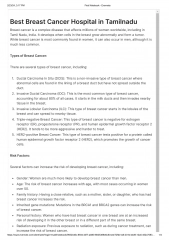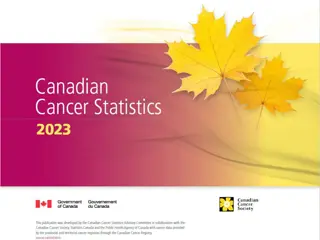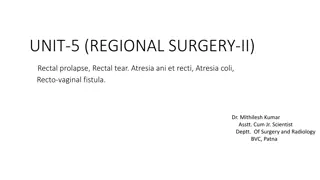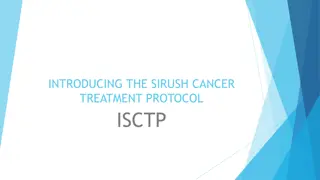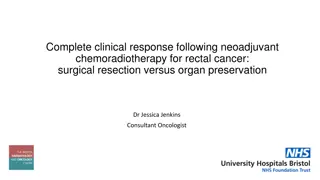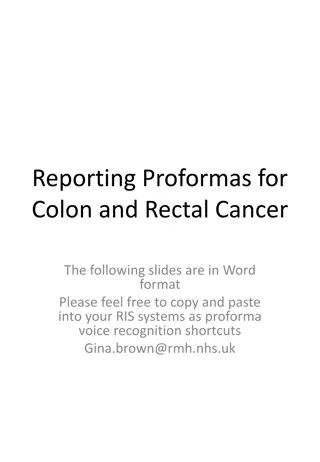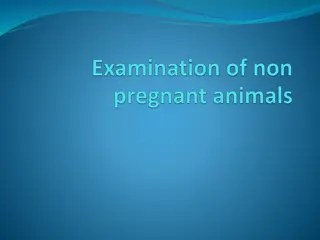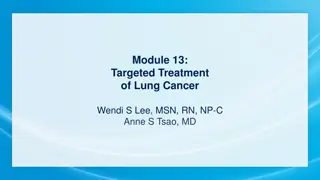Understanding Treatment Options for Stage III Rectal Cancer
Explore the potential treatments for a 83-year-old male diagnosed with Stage III rectal cancer, including surgery, radiation therapy, chemotherapy, and immunotherapy. Learn about neoadjuvant and adjuvant therapies, complete response definitions, surgical techniques like total mesorectal excision (TME), and the role of radiation therapy in increasing local control and overall survival. Dive into valuable insights on the management of non-Stage IV rectal cancer patients.
Download Presentation

Please find below an Image/Link to download the presentation.
The content on the website is provided AS IS for your information and personal use only. It may not be sold, licensed, or shared on other websites without obtaining consent from the author. Download presentation by click this link. If you encounter any issues during the download, it is possible that the publisher has removed the file from their server.
E N D
Presentation Transcript
TOTAL NEOADJUVANT THERAPY TNT
SIMPLIFIED STAGING STAGE I NO LYMPH NODE, SMALL TUMOR STAGE II NO LYMPH NODE, INVADES SUBSEROSA STAGE III LYMPH NODES with cancer STAGE IV Distant METASTASIS FOCUS FOR TODAY IS STAGE II AND III RECTAL CANCER
DEFINITIONS NEOADJUVANT Rx - Rx given before the primary treatment ADJUVANT Rx - Rx given after primary treatment Targets cancer cells that the primary treatment may not have destroyed CLINICAL COMPLETE RESPONSE cCR No visible evidence of tumor in the rectum and mesorectal nodes PATHOLOGIC COMPLETE RESPONSE pCR No viable tumor in primary site/mesorectal lymph nodes in the resected surgical specimen
CASE 83-year-old male diagnosed with stage III rectal cancer. Which of the following treatments would be potentially appropriate? Surgery Radiation therapy Chemotherapy Immunotherapy (FOR NON-STAGE IV DISEASE ??)
SURGERY First modality used Radical surgery, Hartman, anterior rectal resection High local recurrence rate > 30% High rate of distant metastases > 30% Total mesorectal excision (TME) 1986 Dramatic decrease in local recurrence rate, to 4 to 12% BUT distant metastases remained a major problem postop 25 to 30% of patients still developed distant metastatic disease
TOTAL MESORECTAL EXCISION TME goal is complete removal of the rectum, together with the surrounding lymphovascularfatty tissue containing pararectal lymph nodes, preserve nerve fibers that supply the urinary bladder, prostate and vagina INCORRECT CORRECT
RADIATION THERAPY QUESTION ? ? Increase local control. See if that translates to better overall survival Initial studies focused on postop adjuvant radiation therapy vs none Significant decrease in local recurrence noted No overall survival benefit noted. However, high rate of toxicity due to postoperative morbidity Led to the idea of preoperative (NEOADJUVANT) radiation therapy 1985 GITSG 55/33
1985 GITSG Prolongation of the disease-free interval in surgically treated rectal carcinoma Gastrointestinal Tumor Study Group Postop adjuvant therapy versus no adjuvant therapy. Adjuvant therapy consisting of radiation alone, chemotherapy alone, chemotherapy with radiation therapy. Basically 4 groups. Surgery alone was a control arm. Study was significant for finding as compared to surgery, adjuvant therapy decreased rates of local recurrence and improved disease-free survival. No overall survival seen. L LR 55% versus 33% for CRT. TME not the standard. DFI, significantly better with CRT Overall survival same. Note that the chemotherapy used was 5 FU with methyl CCNU. Methyl CCNU later found out not to add any benefit to 5-FU alone and was associated with significant toxicity and hence that was no longer used. The most profound effect was seen in postoperative chemotherapy with radiation therapy.
NEOADJUVANT RADIATION Rx RATIONALE Adequate oxygen supply needed to the treated area for maximum radiation therapy benefit. Tissue hypoxia ? less DNA damage from radiation therapy to the treated area(cancer) Surgery causes disruption of blood supply Theoretically, less oxygen delivered to postoperative site. Higher dose of radiation therapy needed to effectively kill microscopic disease Hence, potentially more toxicity when radiation given post op.
NEOADJUVANT RADIATION Swedish and Dutch studies 1997 and 2001 Radiation before surgery versus surgery alone Significant decrease in local recurrence rate with preop RT. 11% versus 27%, 2% vs 8% Swedish study improved overall survival (TME not standard) 58% vs 48% Dutch study no overall survival benefit. (TME was standard) Key point Preoperative radiation therapy led to a significant decrease in local reduction rate but no overall survival benefit Question How do we further improve local control and overall survival?
1997 Swedish rectal cancer trial. Randomized control trial. Neoadjuvant short course radiation therapy followed by surgery versus surgery alone. Significant decrease in local recurrence rate with neoadjuvant RT. 11% versus 27%. Significant increase in overall survival with neoadjuvant radiation therapy. 58% versus 48%. Caveat. Hospitals were not yet using TME as optimal surgery for rectal cancer. Thus, it is possible that neoadjuvant radiation therapy partially compensated for the suboptimal surgeries performed at that time. Note. Only study that had shown an improvement in overall survival with preoperative radiation therapy. 2001. Dutch colorectal cancer trial. Neoadjuvant radiation therapy followed by surgery. Versus surgery alone. Surgery was standard TME protocol. Significant decrease in local recurrence rate with radiation therapy preoperatively compared to surgery alone. Local recurrence rate 2.4% versus 8.2% 2-year overall survival rate was 82% in both arms. Note that TME was the standardized surgical procedure.
CHEMOTHERAPY Rationale Travels all over the body Potential to kill microscopic local as well as distant metastatic disease Makes radiation therapy work better High-dose chemotherapy depletes immune cells Standard dose chemotherapy impairs immune cells Low-dose chemotherapy selectively impairs certain immune cells T Reg and MDSC cells shield normal cells from cytotoxic T cells and NK cells preventing damage to normal cells But they also shield cancer cells Low-dose chemotherapy selectively impairs T Reg and MDSC cells KEY POINT Low-dose chemotherapy weakens cancer cells, making them more susceptible to radiation treatment
? ADD CHEMOTHERAPY TO RT (NEOADJUVANT CHEMO RT) Multiple strategies. German study 2004. EORTC study 2006. Neoadjuvant radiation therapy, TME, adjuvant chemotherapy Neoadjuvant radiation therapy, TME Neoadjuvant low dose concurrent chemotherapy + RT, TME, adjuvant chemotherapy TME, chemotherapy + concurrent RT, adjuvant therapy KEY POINT. Both studies showed Neoadjuvant low dose chemotherapy concurrent with RT was significantly better than all strategies Significant decrease in local recurrence rate. Decreased short-term and long-term toxicity Increased rate of sphincter preservation Increased rate of overall compliance with treatment No overall survival benefit 6 13, 9 17
LANDMARK STUDY THAT SHAPED THE STANDARD OF CARE FOR RECTAL CANCER LARC. German colorectal study group.2004 Preoperative chemotherapy + concurrent radiation therapy, surgery, followed by adjuvant chemotherapy versus Surgery, Postoperative chemotherapy + concurrent RT, followed by adjuvant chemotherapy At 5 years the local recurrence rate in the preoperative CRT was 6% versus 13% P0.006 5-year overall survival was the same 76% and 74% Acute toxicity grade 3/4 preoperative CRT 27% versus 40%. (P001) Long-term toxicity preop CRT 14% versus 24% in the postop group (P.01) The preoperative treatment consisted of 5040 cGy delivered in fractions of 180 cGy per day, five days per week, and fluorouracil, given in a 120-hour continuous intravenous infusion at a dose of 1000 mg per square meter of body-surface area per day during the first and fifth weeks of radiotherapy. Surgery was performed six weeks after the completion of chemoradiotherapy. One month after surgery, four five-day cycles of fluorouracil (500 mg per square meter per day) were given. Chemoradiotherapy was identical in the postoperative-treatment group, except for the delivery of a boost of 540 cGy. Study established that preoperative chemo RT versus postoperative chemo RT reduce local recurrence rates, decrease toxicity both acute and long-term, increased overall compliance, and increased sphincter preservation. Study was widely accepted and became that the standard of care for treatment of LARC.
Jean-Franois Bosset, EORTC Radiotherapy Group Trial 22921 Preop RT vs Preop CRT+ Adjuvant chemo vs Preop RT+ adjuvant chemo vs preop CRT + Adjuvant chemo Preoperative chemotherapy TWO 5-day courses during Wk 1 and 5 of RT. Fluorouracil was given at a dose of 350 mg per m/2/day, and leucovorin at a dose of 20 mg mg/m2/day. Postoperative chemotherapy was delivered in 4 courses, every 3 weeks, with the same scheme and doses that were used preoperatively. Preop RT local recurrence rate 17% Preop chemo RT 9% (2 cycles of 5-FU/leucovorin preop) Preop RT plus postop chemo 9% (4 courses of postop chemo) Preop chemo RT plus postop chemo 8% (2 cycles chemo preop, 2 cycles chemo postop) Superior local control rates with chemo RT preop compared to preop RT alone. No overall survival benefit.
WHY NO OVERALL SURVIVAL BENEFIT WITH CHEMO STAGE III COLON CANCER, ADJUVANT CHEMOTHERAPY=OVERALL SURVIVAL BENEFIT Adjuvant chemotherapy = FULL dose, not low dose. After surgery. Compliance rate with adjuvant chemotherapy was very poor (43 to 55%) Significant delays in starting adjuvant chemotherapy due to postop complications Patients unable to get the recommended doses due to toxicity Patients unable to get recommended doses at recommended intervals Significant more toxicity getting adjuvant chemotherapy postop Chemo regimens used then were quite different from what is the standard of care today
OPTMIZING TUMOR RESPONSE ? Give ALL therapy before surgery (TNT) ? Increase the INTERVAL between preop therapy and surgery ? RT/concurrent chemo surgery ? full dose chemo surgery ? Combination of above full dose chemo RT/concurrent chemo
TNT=RADIATION/CHEMO LOW DOSE+ FULL DOSE CHEMO, THEN SURGERY Rationale for giving FULL DOSE chemotherapy before surgery Early treatment of micrometastatic disease Decrease in distant metastases Increase in survival rates as a result of decrease in distant metastases Less toxicity. Easier to tolerate chemo preop = Better compliance Administer all the treatments without significant delays or discontinuing treatment Achieve better tumor regression locally in the rectum (pCR). With better pCR, ? increase the odds of organ preservation in selected patients.
2 PIVOTAL TRIALS WITH TNT APPROACH TNT VS STANDARD OF CARE (CHEMO/RT, TME, ADJUVANT CHEMO) 2020 Arthur Affleck IV
RAPIDO AND PRODIGE 2020 TNT VS STANDARD OF CARE (CHEMO/RT,TME, ADJUVANT CHEMO) SIGNIFICANT IMPROVEMENT IN pCR RATES 28% VS 14%, 28% VS 12% SIGNIFICANT DECREASE IN DISTANT METASTASES 20% VS 27% RAPIDO SIGNIFICANT DECREASE IN DISEASE RELATED TREATMENT FAILURE 24% VS 31% RAPIDO SIGNIFICANT IMPROVEMENT IN METASTASES FREE SURVIVAL 80% VS 70% PRODIGE SIGNIFICANT IMPROVEMENT IN DISEASE FREE SURVIVAL 76% VS 69% PRODIGE OVERALL SURVIVAL SAME AT 3 YEARS 89% VS 89% RAPIDO 91% VS 88% PRODIGE
RAPIDO Short course radiation therapy, followed by chemotherapy, (FOLFOX 4 /Cape ox for 18 weeks, followed by TME versus CRT, TME, adjuvant chemotherapy (Cape ox/FOLFOX) 24 weeks. Improved 3-year disease related treatment failure with TNT 24 versus 31% (significant) Increased PCR 28% versus 14%. Significant Decreased distant metastases 20% versus 27% P significant Overall survival at 3 years was the same at 89%. Local recurrence rate is the same in both arms (2020) PRODIGE (2020) FOLFOX (6 cycles, 12 weeks), long course chemoradiation therapy, TME, Cape ox/FOLFOX x4 cycles (8 weeks) versus long course chemoradiation therapy, TME, Cape ox/FOLFOX x24 weeks (12 cycles) 3-year disease-free survival 75% versus 68% (significant) and increased PCR 28% versus 12% 3-year metastases free survival 79% versus 71% P significant. Overall survival of 91% versus 88%. P not significant. Local recurrence rate not reached.
?OPTIMAL SEQUENCE OF TNT FACT NEOADJUVANT FULL DOSE CHEMOTHERAPY ADDED TO NEOADJUVANT RT = BETTER OUTCOMES AND BETTER ODDS OF ORGAN PRESERVATION (NO COLOSTOMY) LONGER INTERVAL FROM NEOADJUVANT THERAPY TO SURGERY= BETTER LOCAL TUMOR RESPONSE(pCR) SO WHICH SEQUENCE IS POTENTIALLY BETTER ? RT+LOW DOSE CHEMO FULL DOSE CHEMO OR RT+LOW DOSE CHEMO TME FULL DOSE CHEMO TME 25 18
OPTIMAL SEQUENCE OF TNT RT+LOW DOSE CHEMO FULL DOSE CHEMO (consolidation) TME FULL DOSE CHEMO RT+LOW DOSE CHEMO (induction) TME CAO/ARO/AIO 12(2019) Consolidation arm Higher pathologic Complete Response (pCR) Less toxicity, increased compliance with all Rx Better odds of Organ Preservation Disease Free Survival at 4 years same between the 2 arms Local recurrence rates same between the 2 arms 25 17 75 5 6
OPTIMAL SEQUENCE OF TNT/ OPRA RT+LOW DOSE CHEMO FULL DOSE CHEMO (consolidation) TME/WATCH & WAIT* FULL DOSE CHEMO RT+LOW DOSE CHEMO (induction) TME/WATCH & WAIT* OPRA TRIAL 2020 At 3years Induction arm Consolidation arm NO COLOSTOMY/NO TME 47% 60% Tumor regrowth -- less in consolidation arm Disease Free Survival same in both arms compared to historical controls *WATCH AND WAIT APPROACH WITH NO TME, ONLY IF IN COMPLETE CLINICAL RESPONSE (cCR) or NEAR COMPLETE cCR 27 40 75
THE TIMING OF RECTAL CANCER RESPONSE TO CRT CONSORTIUM TRIAL 2015 Increase pCR 18% to 25% when average time from RT to surgery was increased to 6 to 11 weeks GERMAN 2019 CAO/AR/AIO 12. Phase 2 RCT of 2 TNT approaches Induction chemotherapy with FOLFOX followed by CRT, followed by TME. CRT was 5-FU oxaliplatin Versus CRT followed by chemotherapy and TME. CRT was the same with 5-FU approximately, chemo was FOLFOX. pCR 25% versus a 17% Lower toxicity Better compliance with CRT Potentially better chances of organ preservation OPRA TRIAL CRT CHEMO TME/WW CHEMO/CRT TME/WW OS not reached. DFS 76% @ 3 yrs, same as historical controls Consolidation arm, 60% colostomy free vs 47% in induction arm Distant met rate 20% @ 3 years, same as RAPIDO Local regrowth 20 vs 40 consolidation vs induction TNT TME/WW 2020/2022 5FU or CAP+RT, FOLFOX/CAPOX x 4 months or FOLFOX/CAPOX x 4 months, 5FU or CAP+RT
WATCH AND WAIT APPROACH ONLY for clinical Complete response/near cCR Surveillance Findings DRE smooth, normal mucosa Endoscopy flat white scar, telangiectasia, absence of both ulcer and nodularity MRI scar not thicker than the rectal wall, dark T2 signal and no visible lymph nodes STRICT Surveillance DRE, endoscopy, CEA every 4 months x 2 years, every 6 months x3 years Rectal MRI every 6 months for 2 years, then annually. CT chest abdomen pelvis annually. NOTE: Local recurrence about 25% Local recurrence occurred within the first 2 years Surgical salvage successful in over 90% of these patients 5-year overall survival 85% 5-year disease specific survival 94% Potential increased chance of distant metastases in those with local regrowth 18% versus 5% in those with no regrowth IMPORTANT TO HAVE THE DISCUSSION WITH PATIENTS
? AVOID CHEMO/RADIATION/SURGERY MSI-High/MMR-deficient rectal cancer Stage II/III 5 to 10% will be MMR-d Immunotherapy (dostarlimab-gxly) 2022 Majority had bulky tumors, 94% node+ 100% clinical COMPLETE RESPONSE @ 6 MONTHS Longer follow up needed Immunotherapy will potentially benefit only about 5 to 10% of all rectal cancer patients Cercek et al, JCO 2020,38,TPS4123
WHAT WE KNOW TME TNT versus CRT ADJUVANT CHEMO TNT SHOULD BE STANDARD FOR STAGE II AND III RECTAL CANCER PREFERRED OPTION IN NCCN PREFERRED SEQUENCE: RT+ LOW DOSE CHEMO, THEN FULL DOSE CHEMO = INCREASED pCR RATES & cCR RATES. INCREASED ORGAN PRESERVATION RATES BETTER QUALITY OF LIFE LOS
WHAT WE KNOW TME TNT versus CRT ADJUVANT CHEMO: INCREASED DISEASE-FREE SURVIVAL DECREASED LOCAL RECURRENCE RATES DECREASED DISTANT METASTASES DECREASED TREATMENT RELATED FAILURE DECREASED TOXICITY
CASE 83-year-old male diagnosed with stage III rectal cancer. Which of the following treatments would be potentially appropriate? Surgery Radiation therapy Chemotherapy Immunotherapy Alone
CASE 83-year-old male diagnosed with a stage III rectal cancer. Which of the following treatments would be potentially appropriate? Surgery Radiation therapy Chemotherapy Immunotherapy Alone Yes Yes Yes Possibly No in some patients Possibly No in some patients Possibly No in some patients YES !!
SO 1. The Rx of locally advanced rectal cancer has evolved dramatically over the last 20 years. 2. Multidisciplinary approach 3. One size fits all no longer appropriate. Rx needs to be individualized. 4. A good proportion of patients may be spared surgery. 5. Very small proportion of patients may be spared surgery, chemotherapy and radiation and be treated with immunotherapy alone.


